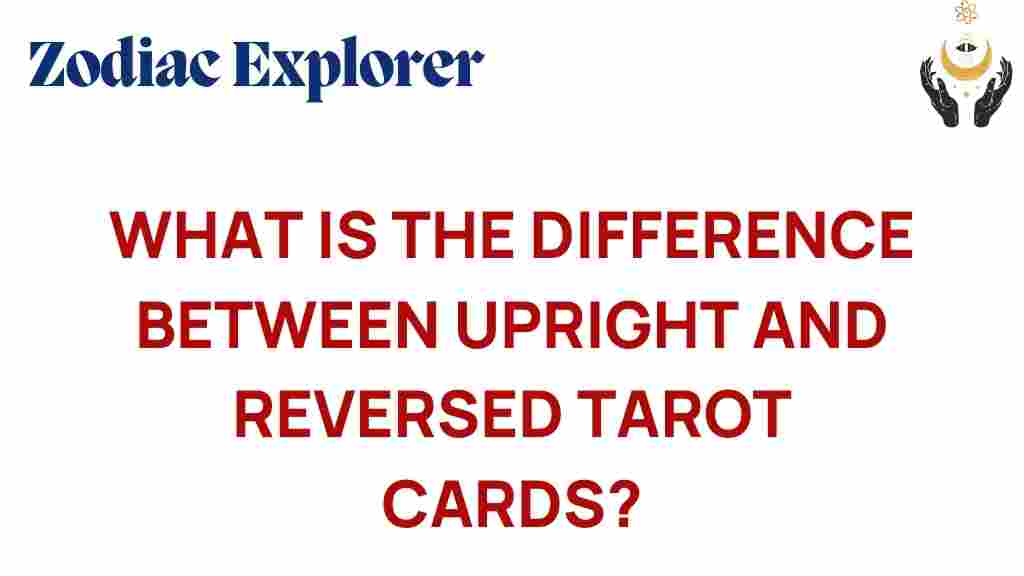Unveiling the Secrets: Upright vs. Reversed Tarot Cards
Tarot cards have captivated the imagination of individuals seeking insight into their lives for centuries. As tools for divination, they offer a unique blend of intuition, symbolism, and interpretation. Understanding the difference between upright cards and reversed cards is crucial for anyone looking to delve deeper into tarot meanings. In this article, we will explore the intricacies of upright and reversed tarot cards, their interpretations, and how they can enhance your card reading experience.
Understanding Tarot Cards
At their core, tarot cards are a deck of 78 cards divided into major and minor arcana. Each card carries a specific meaning, and the way they are drawn—upright or reversed—can significantly alter their interpretations. The upright cards typically represent positive aspects or upright qualities, while reversed cards often indicate challenges or obstacles.
The Importance of Card Orientation
The orientation of tarot cards is essential in the art of divination. Here are some points to consider:
- Upright Cards: These cards usually signify positive traits, clarity, and forward movement. They often embody the essence of the card’s meaning.
- Reversed Cards: These cards can reveal hidden aspects or may indicate a need for reflection. They often suggest the opposite of the upright meaning or a blockage in energy.
Exploring Upright Cards
Upright tarot cards are the foundation of a card reading. They provide a clear and direct message regarding the querent’s situation. Here’s how to interpret upright cards:
Common Themes in Upright Cards
Upright cards typically resonate with themes of:
- Success: Representing achievement and positive outcomes.
- Growth: Indicating personal or spiritual development.
- Openness: Suggesting clarity and honesty in situations.
- Positive Relationships: Reflecting harmony and connection with others.
How to Read Upright Cards
Reading upright cards involves using your intuition alongside the traditional meanings. Here’s a step-by-step approach:
- Focus on Your Question: Before drawing cards, concentrate on what you want to know.
- Draw Your Cards: Shuffle the deck and draw the cards, laying them out in your chosen spread.
- Interpret the Meanings: Begin by considering the individual meanings of each upright card.
- Connect the Cards: Look for patterns, relationships, and how the cards interact with each other.
Diving into Reversed Cards
Reversed tarot cards can be daunting for beginners, but they are equally important. They provide depth and complexity to your readings. Here’s how to understand reversed cards:
Common Themes in Reversed Cards
Reversed cards often touch on themes such as:
- Blockages: Indicating obstacles that may hinder progress.
- Reflection: Suggesting a need for introspection and self-evaluation.
- Miscommunication: Highlighting issues in relationships or misunderstanding.
- Delayed Results: Signaling that outcomes may take longer to manifest.
How to Read Reversed Cards
Reading reversed cards requires a slightly different approach. Follow these steps:
- Consider the Energy: Think about what the reversed position might signify—opposition, blockage, or an internal struggle.
- Use Intuition: Trust your gut feelings about the reversed meanings.
- Look for Patterns: Just as with upright cards, observe how reversed cards relate to others in the spread.
The Symbolism Behind Tarot Cards
Each tarot card is rich with symbolism, which adds layers to their meanings. Understanding these symbols can enhance your readings. Here are a few examples:
- The Fool: Represents new beginnings, spontaneity, and adventure (upright), while reversed can indicate recklessness or a lack of direction.
- The Lovers: Signifies partnership and harmony (upright), but reversed may suggest disharmony or difficult choices.
Interpreting Symbolism in Context
When interpreting the symbolism of tarot cards, consider the context of the reading. The surrounding cards can provide essential insights into the meaning, whether upright or reversed. Always relate the symbols to the querent’s question and life situation.
Troubleshooting Common Issues in Tarot Readings
Even experienced readers can encounter challenges. Here are some common issues and how to overcome them:
1. Confusion About Card Meanings
If you find yourself confused about the meanings of certain cards, consider the following:
- Consult a Reference: Use a reliable tarot guidebook or online resource for clarification.
- Practice: Regular practice with the cards can help solidify your understanding.
2. Difficulty Connecting with Intuition
If your intuition feels blocked, try these techniques:
- Meditation: Spend time in meditation to clear your mind and enhance your intuitive abilities.
- Journaling: Keep a tarot journal to record your thoughts and feelings about each card.
3. Overwhelmed by Reversed Cards
Reversed cards can be intimidating. To handle them better:
- Don’t Panic: Remember that reversed cards provide opportunities for growth and reflection.
- Reframe the Message: Look for the lesson in the reversed meaning rather than solely focusing on the challenges.
Conclusion
Understanding the differences between upright and reversed tarot cards is essential for effective card reading. By mastering the meanings and interpretations of both orientations, you can unlock a deeper level of insight and intuition in your tarot practice. Whether you’re seeking guidance for yourself or others, embracing the duality of tarot cards will enhance your divination experience.
For more information on tarot card meanings and techniques, consider exploring resources like tarot.com for comprehensive guides and community support. Happy reading!
Remember, tarot is a journey of self-discovery and understanding, and every card drawn is an opportunity to learn more about yourself and the world around you.
This article is in the category Myths and created by ZodiacExplorer Team
